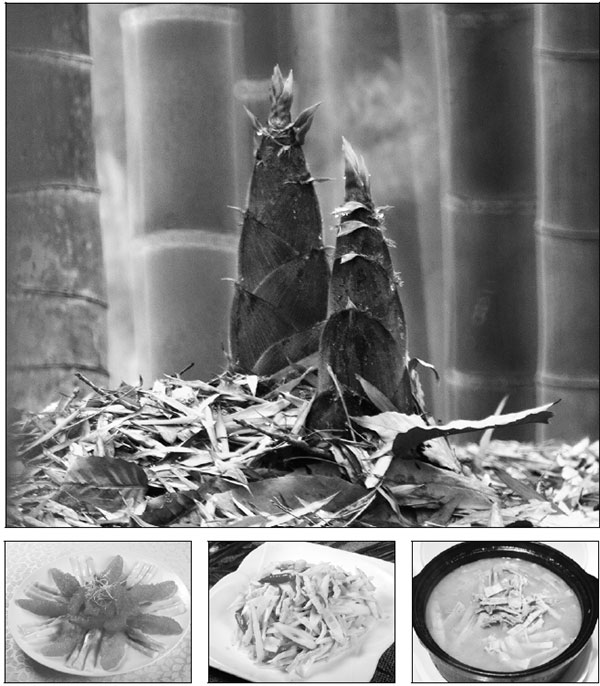Eating bamboo
It's a grass, all right, but one that has grown to occupy a special - if not surprising - place in Chinese gastronomy.
The mighty bamboo starts small. And if you catch them as they just emerge, bamboo shoots are tender, juicy and full of flavor.
Bamboo grows all over China and - despite its height - is actually a grass. It is quick-growing and covers large tracts of land all over southern and southwestern China.
It is a pliable material that is used to make everything from entire houses to baskets as small as a cricket's cage. Use of bamboo furniture, such as sets of tables and chairs, ladders, hoes, trays and mats is legion and, sometimes, unexpected.
In Sichuan, for example, they specialize in tiny delicate spoon-like contraptions that are designed to clean the inside of ears.
Apart from its vast range of utilitarian purposes, bamboo also produces bamboo shoots, a uniquely Chinese ingredient seldom seen in other cuisines.
Yes, Korean and Japanese cooking make use of bamboo shoots, too, but no one prepares them like the Chinese chef.
When the spring thunderstorms come, the bamboo forests wake. As the rain soaks into the earth, dormant shoots that have been hibernating underground all winter start to swell and poke their tips through the ground.
Even before their tender tops can pierce through the surface, they are quickly spotted and harvested. These fat "winter shoots" are boiled to get rid of the white alkali crystals in their hearts and stripped of their inedible outer leaves.
Lightly salted water will help them keep longer, and they are canned or bottled quickly, ending up in homes and restaurants as the thin, cream-colored slices we all know.
Bamboo shoots must be processed as soon as they are harvested, or they will quickly deteriorate once out of the ground. In southwestern China, the mountains of the Guangxi Zhuang autonomous region produce slender shoots that are harvested only when they are about 10 centimeters long.
They are dug out in the hills and sent by a flying-fox system down to the valley where a busy production line strips them of leaves and pickles them immediately.
This is the famous suansun, the tangy pickled bamboo shoots that go into practically every bowl of noodles in that region.
Nearer the Jiangsu-Zhejiang area, equally tender shoots are brined whole in sugar and salt for the famous "hand-stripped bamboo shoots", shoubosun.
They are delicious as a chilled appetizer, or as an accompaniment to millet or bean porridge.
The Cantonese eat bamboo shoots all year-round, from the fresh winter shoots to brined chunks to young fresh shoots cooked in a savory liqueur and served on a bed of shaved ice.
Bamboo shoots are finely diced and used in classic dumplings to add that tactile crunch and sweetness. It is also widely used in Cantonese dim sum, playing a crucial background role in everything from wantons to bean curd rolls.
My Cantonese grandmother's favorite bamboo recipe was braised preserved bamboo with pork belly in a fermented red bean curd sauce.
It is an old village classic.
The bamboo shoots resembled mummified pieces of an unknown object. It took days of repeated soaks and blanching in hot water to get rid of its strong stench of ammonia. By the end of four days, or maybe more, the bamboo shoots began to resemble their former selves.
They were then dropped into boiling water for an hour more and drained for a final soak in cold water.
Fatty pork belly is seared in a wok to render the fat and the bamboo shoots are added. Finally, a few pieces of fermented red bean curd are dissolved in Chinese liquor with sesame oil and added to the braising pot.
This is when the alchemy happens. Bamboo shoots, fatty pork, liquor and seasoning cook down into a mouth-watering emulsion.
The pork melts away in the mouth. The bamboo shoots retain their crunch but absorb all the sweetness of the meat through a magical osmosis. And our whole family would polish off the entire platter in no time, aided by generous bowls of steamed white rice.
It is a time-consuming dish to make, which takes a week from start to finish, but one that never tasted better.
Bamboo shoots are popular in Sichuan as well, where they are shredded and pickled in large jars topped with bright-red chopped chilies and neon-lit chili oil. As a result, they are full of umami flavors, and a little saucer will chase down a huge bowl of noodles, rice or porridge.
It takes an excellent chef to coax such flavors from the bland little bamboo shoot, but then the Chinese chef has always had a talent for creating ambrosia out of the most ordinary ingredients.
paulined@chinadaily.com.cn
|
Bamboo shoots are enjoyed by Chinese people all across the country. Photos provided to China Daily |
(China Daily Global 04/26/2019 page16)



















